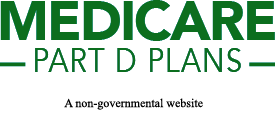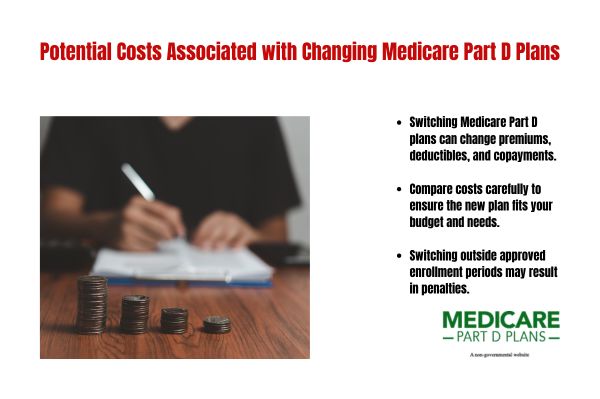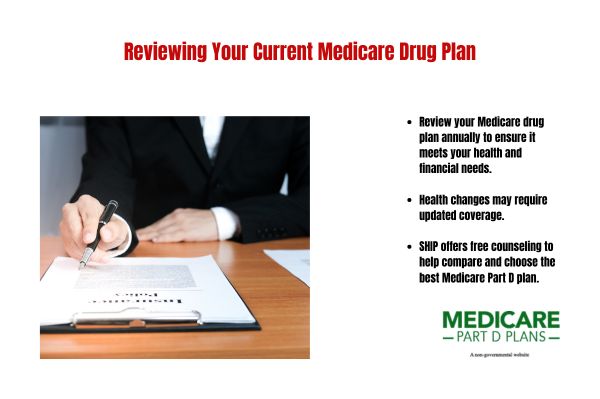Find a Medicare Part D prescription drug plan

Medicare Part D
Prescription Drug Coverage 2026
Can You Change Medicare Part D Plans Anytime?
You cannot change Medicare Part D plans anytime. Typically, changes may be made during specific enrollment periods such as the annual open enrollment period (October 15 to December 7) and special enrollment periods triggered by certain life events. This article will guide you through when and how you can switch your Medicare Part D plan.
Key Takeaways
- Medicare Part D plan changes may only be made during specific enrollment periods like the annual open enrollment from October 15 to December 7, or during special enrollment periods triggered by life events.
- Switching plans may lead to automatic disenrollment from the previous plan, with new coverage starting on January 1 if enrolled during the annual period; careful consideration of coverage gaps will likely be essential.
- Comparing costs, such as premiums and copayments, may be critical when switching plans; beneficiaries should verify medication formularies and pharmacy networks to help avoid unexpected expenses.
Understanding Medicare Part D Plan Changes
Knowing when and how to change Medicare Part D plan will likely be key to having the best coverage possible. Medicare Part D plans, which may be stand-alone or part of Medicare Advantage plans, will likely offer prescription drug coverage to help manage the cost of medications. However, changes to these plans may only occur during specific times or under certain conditions.
Knowing these certain times and conditions could allow you to adjust as needed, whether it’s during the annual open enrollment period, a special enrollment period due to a life event, or other qualifying circumstances where you are enrolled during the advantage open enrollment period within the calendar year.
Annual Open Enrollment Period
The annual open enrollment period for Medicare Part D plans runs from October 15 to December 7 each year. During this time, beneficiaries can make changes to their plans, such as switching to a new Medicare Part D plan or adjusting their current coverage. Enrolling early in the enrollment period can help prevent potential gaps in coverage.
Changes made during the annual open enrollment period take effect on January 1 of the following year. This period will likely be crucial to ensure that your drug plan continues to meet your needs, as costs and coverage may change from year to year.
Special Enrollment Periods (SEPs)
Special Enrollment Periods (SEPs) allow beneficiaries to make changes to their Medicare plans outside the annual open enrollment period due to specific life events. These events might include moving out of a plan’s service area, losing other health coverage, or experiencing a significant change in income or marital status.
If you qualify for a SEP, you can switch or enroll in a new plan without waiting for the next annual open enrollment period. Acting promptly during these periods could help avoid penalties and possibly ensure continuous coverage.
Switching Plans Due to Life Events
Certain life events, such as relocating to a new area or losing job-based insurance, may grant you the opportunity to switch Medicare Part D plans mid-year. These events trigger a special enrollment period, likely to allow you to make necessary adjustments to your coverage to better suit your new circumstances.
The timing for switching plans due to life events might vary. Typically, you have a window of two months to change plans once the event occurs. Keeping track of these deadlines could help ensure you maintain continuous coverage without any gaps.
What Happens When You Switch Medicare Part D Plans?
Switching Medicare Part D plans will likely involve several steps and considerations. During the enrollment periods, beneficiaries may change their plans as often as they wish. However, it’s essential to understand what happens once you make the switch.
Switching plans will likely result in automatic disenrollment from your previous plan. This occurs when the new coverage starts. This automatic disenrollment could help prevent overlapping coverage and possibly ensure a smooth transition to your new plan.
Coverage Begins with New Plan
When you switch to a new Medicare Part D plan, the new coverage typically begins on January 1 of the following year if changes are made during the annual open enrollment period. This may help ensure that there are no interruptions in your prescription drug coverage.
If you switch plans outside of the open enrollment period due to a special enrollment period, the drug plan coverage begins may depend on the specific circumstances of the enrollment.
During the transition to your new plan, you may receive transition supplies of your prescription drugs to avoid any gaps in coverage. You could also submit coverage determination requests to confirm that necessary medications are covered under your new plan.
Potential Gaps in Coverage
To avoid gaps in coverage when switching Medicare Part D plans, it’s advisable to enroll at the start of an enrollment period. This proactive approach could help ensure that your new plan coverage begins seamlessly without any interruptions. Members may be automatically disenrolled from their previous plan when the new one starts, further preventing overlapping coverage issues.
If you switch plans after the first 60 days of the year, your current plan should continue covering drugs that may have been removed from the formulary until the end of the year. This regulation will likely protect you from sudden changes in your medication coverage and possibly ensure continuity of care.
Potential Costs Associated with Changing Medicare Part D Plans
Switching Medicare Part D plans may lead to varying costs, such as monthly premiums, deductibles, and copayments. Carefully considering these financial aspects before switching could help ensure that your new plan aligns with your budget and healthcare needs.
Different plans may come with different costs, and it’s not uncommon to encounter significant premium hikes when switching plans. Additionally, switching plans might result in potential penalties if not done during the appropriate enrollment periods. Let’s break down these costs further.
Monthly Premiums
Monthly premiums for Medicare Part D plans may vary significantly depending on the plan you choose and your income level. When switching plans, individuals may encounter different premium rates, which could potentially impact their overall healthcare budget. Researching and comparing the potential costs associated with new plans may help avoid unexpected expenses.
Failing to consider the premium differences could lead to financial strain, especially if the new plan’s premiums are substantially higher than your current plan. Being aware of these lower costs could help you make a more informed decision when switching plans.
Deductibles and Copayments
In addition to monthly premiums, switching Medicare Part D plans might involve varying deductibles and copayments. These costs will likely be crucial to consider as they could directly impact your out-of-pocket expenses for prescription drugs. Different plans may have different structures for deductibles and copayments, so it’s essential to understand how these might affect your overall healthcare costs.
If you enroll in a new plan late, you may face penalties that might increase your monthly premium. Understanding these additional costs and seeking extra help could help you budget more effectively and avoid financial surprises.
Late Enrollment Penalties
A late enrollment penalty will likely be calculated based on the number of uncovered months a beneficiary was eligible for Medicare drug coverage but did not enroll. This penalty might be added to your monthly premium and could potentially increase your overall costs. If you delay enrolling in a Part D plan and later decide to join, you may incur a penalty that increases your premium.
The potential financial impact of these penalties could be substantial, so it’s crucial to enroll during the appropriate periods to avoid these additional costs. Being aware of these penalties will likely ensure that you make timely decisions regarding your Medicare Part D coverage.
Reviewing Your Current Medicare Drug Plan
Regularly reviewing your current Medicare drug plan could help ensure it continues to meet your health and financial needs. As your health needs change, so might your coverage requirements. Evaluating your plan annually may help you decide whether to switch plans or stay with your current one.
State Health Insurance Assistance Programs (SHIP) offer free counseling services to help individuals understand their Medicare Part D options and choose suitable plans. These services can be invaluable in navigating the complexities of Medicare and possibly ensuring you have the best coverage for your needs.
Annual Notice of Change (ANOC)
The Annual Notice of Change (ANOC) is a document sent by your Medicare plan each fall, detailing any potential changes to your plan for the upcoming year.
This might include updates to costs, covered medications, and network services that will likely take effect in January. Reviewing the ANOC could be crucial to understanding how potential changes could impact your coverage and costs.
By carefully examining the ANOC, you will likely be able to determine if your current plan could still meet your needs or if you need to consider switching to a new plan. This proactive approach will likely help you stay informed and make necessary adjustments well in advance.
Evidence of Coverage (EOC)
The Evidence of Coverage (EOC) will likely provide comprehensive information about your Medicare plan’s coverage, possible costs, and services. It will likely outline the potential benefits, possible coverage limitations, and exclusions, making it critical to review annually. Understanding the details in the EOC could help you know your rights and responsibilities under the plan.
The EOC may also include information about coverage specifics and appeal procedures, possibly ensuring you are well-informed about what your plan covers and how to address any issues. Regularly reviewing the EOC could help ensure that you are fully aware of your plan’s benefits and any changes that may affect your other coverage.
See plans in your area instantly!
Advertisement
Tools and Resources for Comparing Medicare Part D Plans
Numerous tools and resources will likely be available to help you compare Medicare Part D plans and find the best fit for your needs. These resources could provide valuable insights into the potential costs and coverage options available, allowing you to make informed decisions about your healthcare.
This website and calling one of our licensed agents are two primary resources that can assist you in evaluating different plans. Let’s explore how these tools can help you choose the right Medicare Part D plan.
Our Website
By entering your zip code into the Plan Finder Tool on this website, members can input their medications and compare costs among available Part D plans. This website enables users to enter their medication lists and find plans that best fit their needs. By using this website, you can receive customized plan options based on coverage and costs.
Each Medicare Part D plan will likely have a formulary that lists covered drugs, which may vary significantly between plans. Additionally, specific pharmacy networks might dictate where beneficiaries can fill their prescriptions, likely making it crucial to confirm that your preferred pharmacy is part of the new prescription drug plans network.
Personalized Counseling Services
The State Health Insurance Assistance Program (SHIP) provides essential support and guidance for Medicare beneficiaries looking to navigate their Part D options. SHIP’s personalized assistance could help you understand your options, receive tailored advice, and make informed decisions about your Medicare Part D plans.
Personalized assistance could help individuals account for their unique needs, preferences, and health conditions when selecting or changing their Medicare plan. This support could potentially ensure that you choose the most suitable plan for your specific situation.
Common Mistakes to Avoid When Switching Plans
Switching Medicare Part D plans might be a complex process, and it’s essential to avoid common mistakes that might lead to unexpected costs or coverage issues. By being aware of these pitfalls, you could make a more informed decision and possibly ensure a smoother transition to your new plan.
Two common mistakes to watch out for might be ignoring formularies and overlooking pharmacy networks. Let’s delve into these potential pitfalls and know how to avoid them.
Ignoring Formularies
Verifying that your medications may be included in the new plan’s formulary will likely be crucial to ensure continued coverage of necessary prescriptions. Not checking this information could lead to higher out-of-pocket costs if your medications are not covered under the new plan.
Patients should always verify that their necessary medications are listed in the new plan’s formulary to help avoid unexpected expenses.
Ignoring the formulary might result in financial strain, likely making it essential to review this information carefully before switching plans. This step could help ensure that you maintain access to your necessary medications without additional costs.
Overlooking Pharmacy Networks
Some Medicare Part D plans may have specific pharmacy networks where beneficiaries must obtain their medications, which may offer lower costs and maximum coverage.
Before switching to a new plan, members should check whether your preferred pharmacy may be included in its network. Failing to do so could potentially result in unexpected out-of-pocket expenses and limited access to necessary medications.
Ensuring that your preferred pharmacy may be part of the new plan’s network could help you avoid these issues and likely ensure seamless access to your prescriptions.
Find a Plan and Enroll Online Yourself!
Advertisement
Summary
Navigating the maze of Medicare Part D might be challenging, but understanding the key aspects of changing plans could make the process much smoother. From knowing when you can switch plans during the annual open enrollment period or special enrollment periods to understanding the potential costs and coverage gaps, being well-informed is crucial.
Reviewing your current plan regularly and utilizing the available resources can help you make the best decision for your healthcare needs. By avoiding common mistakes such as ignoring formularies and overlooking pharmacy networks, you could potentially ensure that your transition to a new Medicare Part D plan is seamless and cost-effective.
Stay informed, use the available resources, and make proactive decisions could help maintain optimal prescription drug coverage. Remember, the right plan may significantly impact your health and financial well-being, so take the time to choose wisely.
Frequently Asked Questions
Can I change my Medicare Part D plan outside the annual open enrollment period?
Yes, you may be able to change your Medicare Part D plan outside the annual open enrollment period during special enrollment periods, which are triggered by qualifying life events, such as moving or losing other health coverage.
What happens if I switch my Medicare Part D plan after the annual open enrollment period?
If you switch your Medicare Part D plan outside the annual open enrollment period, you may do so only if you qualify for a special enrollment period, which allows for changes based on specific situations. Your new plan’s coverage will likely start according to the circumstances of your enrollment.
Are there any penalties for switching Medicare Part D plans?
Yes, there may be no penalties for switching Medicare Part D plans during designated enrollment periods. However, enrolling late or missing these periods may lead to a late enrollment penalty on your monthly premium.
How could I compare different Medicare Part D plans to find the best one for me?
To find the best Medicare Part D plan for you, enter your zip code into the Plan Finder Tool on this website to compare costs and coverage, and consider calling one of our licensed agents for personal assistance at 1-866-930-4039 (TTY 711) Mon-Fri: 8am-8pm EST.
What should I check before switching to a new Medicare Part D plan?
Before switching to a new Medicare Part D plan, members should confirm that their medications are covered under the plan’s formulary and that your preferred pharmacy is part of the plan’s network. This could help you avoid unexpected costs.
Begin Choosing your plan
Advertisement
ZRN Health & Financial Services, LLC, a Texas limited liability company.




